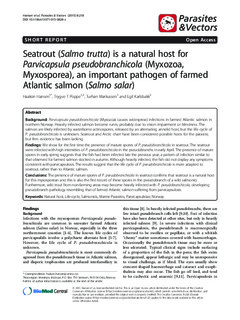| dc.contributor.author | Hansen, Haakon | |
| dc.contributor.author | Poppe, Trygve T | |
| dc.contributor.author | Markussen, Turhan | |
| dc.contributor.author | Karlsbakk, Egil | |
| dc.date.accessioned | 2015-06-24T13:36:20Z | |
| dc.date.accessioned | 2015-07-27T08:54:24Z | |
| dc.date.available | 2015-06-24T13:36:20Z | |
| dc.date.available | 2015-07-27T08:54:24Z | |
| dc.date.issued | 2015-04-10 | |
| dc.identifier.citation | Parasites & Vectors 2015, 8(1) | nb_NO |
| dc.identifier.issn | 1756-3305 | |
| dc.identifier.uri | http://hdl.handle.net/11250/293610 | |
| dc.description | - | nb_NO |
| dc.description.abstract | Background: Parvicapsula pseudobranchicola (Myxozoa) causes widespread infections in farmed Atlantic salmon in
northern Norway. Heavily infected salmon become runts, probably due to vision impairment or blindness. The
salmon are likely infected by waterborne actinospores, released by an alternating annelid host, but the life cycle of
P. pseudobranchicola is unknown. Seatrout and Arctic charr have been considered possible hosts for the parasite,
but firm evidence has been lacking.
Findings: We show for the first time the presence of mature spores of P. pseudobranchicola in seatrout. The seatrout
were infected with high intensities of P. pseudobranchicola in the pseudobranchs in early April. The presence of mature
spores in early spring suggests that the fish had been infected late the previous year, a pattern of infection similar to
that observed for farmed salmon stocked in autumn. Although heavily infected, the fish did not display any symptoms
consistent with parvicapsulosis. The results suggest that the life cycle of P. pseudobranchicola is more adapted to
seatrout, rather than to Atlantic salmon.
Conclusions: The presence of mature spores of P. pseudobranchicola in seatrout confirms that seatrout is a natural host
for this myxosporean and this is also the first record of these spores in the pseudobranch of a wild salmonid.
Furthermore, wild trout from non-farming areas may become heavily infected with P. pseudobranchicola, developing
pseudobranch pathology resembling that of farmed Atlantic salmon suffering from parvicapsulosis | nb_NO |
| dc.language.iso | eng | nb_NO |
| dc.publisher | BioMed Central | nb_NO |
| dc.rights | Navngivelse 3.0 Norge | * |
| dc.rights.uri | http://creativecommons.org/licenses/by/3.0/no/ | * |
| dc.title | Seatrout (Salmo trutta) is a natural host for Parvicapsula pseudobranchicola (Myxozoa, Myxosporea), an important pathogen of farmed Atlantic salmon (Salmo salar) | nb_NO |
| dc.type | Journal article | nb_NO |
| dc.type | Peer reviewed | nb_NO |
| dc.date.updated | 2015-06-24T13:36:20Z | |
| dc.subject.nsi | VDP::Landbruks- og fiskerifag: 900::Fiskerifag: 920::Fiskehelse : 923 | nb_NO |
| dc.subject.nsi | VDP::Agriculture and fisheries science: 900::Fisheries science: 920::Fish health: 923 | nb_NO |
| dc.source.pagenumber | 4 p. | nb_NO |
| dc.source.volume | 8 | nb_NO |
| dc.source.journal | Parasites & Vectors | nb_NO |
| dc.source.issue | 1 | nb_NO |
| dc.identifier.doi | 10.1186/s13071-015-0828-z | |
| dc.identifier.cristin | 1250018 | |

